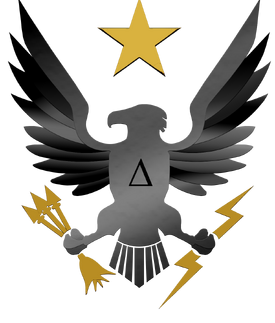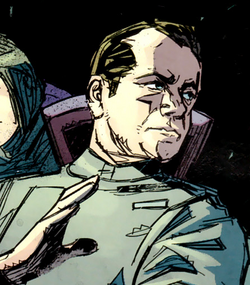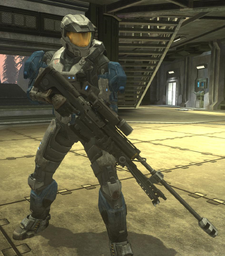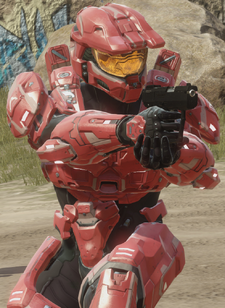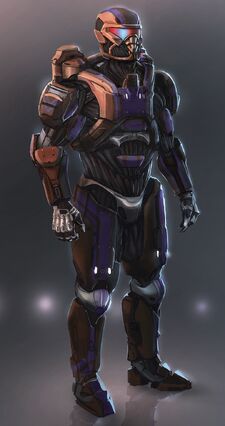
|
This article, Delta Company, was voted as the Legendary Article of 2016 in the 2016 Annual Halo Fanon Wikia Awards. |

|
This article, Delta Company, written by Coolbuddy379, KingOfYou115, Sev40, and Shivly, was voted as the Best Organization of 2016 in the Ninth Annual Halo Fanon Wikia Awards. |
| This fanfiction article, Delta Company, was written by Coolbuddy379, KingOfYou115, Sev40 and Shivly. Please do not edit this fiction without the writers' permission. |
| This article, Delta Company, is currently under active construction. |
| This is a fanon expansion of a canon element. To see the original canon article, follow the link to Halopedia: Delta Company. |
The fourth generation of the SPARTAN-III Program, Delta Company, formally known as ORION Generation-III, Class IV, was a rogue class of super-soldiers developed in secret by the Beta-5 Division. Formed from the consenting candidates recovered between 2551 and 2552, the project was a radical change from its predecessors, with each Spartan intended to survive longer and used in smaller-scale stealth missions, rarely ever being deployed as a complete unit. For this reason, their five-year training program emphasized their ability to work as a team while also rewarding some independent decision-making skills. At the same time, attachments or bonds to non-Spartans who weren't their commanding officer or even their peers in other teams were strongly discouraged, with each team developing a strong sense of competitiveness against each other. This training structure allowed them to perform best against comparable opponents such as Elites, Brutes and even other spartans. Although the company was ultimately disbanded after being discovered, the Deltas continued to be a vital weapon against high-value targets such as rogue spartans for years afterwards. Role & UsageThe highly-secret SPARTAN-III program, started by Colonel James Ackerson and Lieutenant Commander Kurt Ambrose was created in order to create cheap and expendable soldiers who would embark on suicide missions with high strategic importance and an equally high risk. The first set of the soldiers, called as Alpha Company, were all wiped out during Operation: PROMETHEUS, and similarly the second set called Beta Company were killed in Operation: TORPEDO. Soon after the graduation of Gamma Company, the Human-Covenant war worsened, and its Spartans were called to assist the mainline human forces. After the Gamma Company Spartans were taken out, new plans were being made for the next set of soldiers, Delta Company. All the resources and materials, whatever needed for Delta Company were transported to Onyx to set up everything and commence the training by the frigate the UNSC Agincourt. Before the frigate left, Lt. Commander Ambrose asked the ship for assistance in observing the competition between the top three Gamma Company teams, Saber, Katana, and Gladius on Onyx in order to get the top honors. However, the entire situation changed when the Onyx Sentinels attacked, resulting in the Onyx Conflict and the death of Ambrose. Soon after that, during the Battle of Mare Erythraeum, Colonel Ackerson was taken prisoner by the Covenant and subsequently killed. Without the two heads running the program, Delta Company was shut-down by the Office of Naval Intelligence, and all its funding was diverted to the ongoing war. All traces of it were removed from the computers and its files were purged, although the top-ranking ONI brass still knew about it. However, it was soon suggested by Beta-5's director Jazmine Utah, on such official for Delta Company to be revived. Originally meeting with criticisms, after the occurrence certain incident, Utah, along with Commander Andrew Johnson, secretly revived the project for personal uses. Delta was trained in order to become ONI's top-ranking officials' personal bodyguards, an idea taken from Dr. Catherine Halsey who had one of her own SPARTAN-II as her bodyguard. The Deltas were originally supposed to be the protectors of the officials, but that wouldn't be sufficient to explain the high number of recruits. Thus, their field of expertise was expanded to include black operations and guerrilla warfare. The Deltas were basically Beta-5's personal army of Spartans, which made them indirectly, but dangerously powerful, especially Utah. HistoryOrigins and Selection
Though the selection process for the future members of Delta Company was in a process of rushing in 2551 to 2552, the origins of the selection could be found four years before. With Gamma Company's training well underway, agents from Section-II began analysing data from the recent 2545 CAA Human Citizen Census and the on-going vaccination programs to find possible candidates who may fulfil the age range that was sort after in earlier companies. Those who met the genetic profile sought were then organised by the likelihood their planet would be invaded by the Covenant, then the risk of how likely their home cities or towns would be chosen as targets for the Covenant. As time went on, measures were put in place to ensure what as many potential candidates survived, including creating child-only evacuation craft. To avoid losing track of the candidates in other orphanages across the remaining worlds, as what happened to previous companies in the past, they were injected with a newly-developed organic tracking solution into their bloodstream. This was all completed by 2549, when enough possible candidates had been surveyed that made the fourth company viable. When 2551 came around, however, enough problems arose that required another validation of the remaining candidates on the list. This was caused by two main problems. Firstly, while ONI was successful at guaranteeing the safety of most of the candidates, a small portion was located on worlds that had not been attacked, but bypassed entirely by the Covenant's invasion fleets. This made those candidates harder to interview and retrieve, much less want to leave in the first place, resulting in them being cut from the list. Secondly and most significantly was Ambrose's research into augmentation failures. He released a new set of required genetic markers based on incompatible gene sequences which led to their bodies rejecting the drugs, resulting in a complete re-evaluation of the candidates. When all this was finished, the number of children compatible dropped from just over three hundred to half that number. With the future of his brainchild now in risk, it didn't take long for Ackerson to find out.
With pressure from even higher-ranking ONI officers such as Admiral Parangosky, Ackerson authorized the creation of at least four hundred and seventy-five soldiers. To gain such vast amounts of soldiers, he made a number of changes to the selection criteria; many of which were based on those used by the older Gamma Company. Predictably, Ackerson's orders to downgrade the genetic code requirements to "recommended" infuriated Ambrose, who immediately and stubbornly demanded those to be reinstated as mandatory. However, as Ambrose had no alternate ideas for how to get so many candidates, it stood for the rest of the selection process. Luckily for Ambrose, these measures proved to be unnecessary when in 2552 a new wave of orphans resulted from the destruction of the Epsilon Eridiani colonies; a horrible price to allow the continuation of the SPARTAN-III program. Even while Section-II was still cataloging the possible candidates present in the refugee camps, both Ackerson and Ambrose reluctantly allowed them to begin evaluating and if possible recovering them. Because of this, by the Battle of Onyx right at the end of the war, four hundred and ninety-seven candidates had been surveyed for possible proposal and at least three hundred and forty had already been recovered. However, at this time the candidate collection stopped; the deaths of both the administrators and many of the employees of the SPARTAN-III program left almost nobody to run it. Coupled with ONI's public support for the SPARTAN-IV Program, there was also little interest in establishing what could be argued as an obsolete program. Reestablishment and RecruitmentHowever, not all high-ranking ONI officials saw the redundancy of another class of SPARTAN-IIIs. Admiral Jazmine Utah, the ruthless director of Beta-5's special projects, was merely the only one to take action. She was concerned that massive breach of security that was GEN2 MJOLNIR and the SPARTAN-IVs, along with the illegal drugs that the Gamma Company Spartans took, would eventually culminate in a supersoldier crisis within the next few decades. The easiest solution was to use the recruited Delta candidates and modify their planned training regime and equipment to make them much more efficient at killing other Spartans. There was a large problem, and one which threatened to shut down the company before it even begun; how to gain a large-enough budget to pay for all of this, since HIGHCOMM would never approve of this for obvious reasons. In the end, it was decided that as well as setting up false charities, she and a couple of her most trustworthy officers would approach a number of commanders in all branches of the UNSC which were most likely to support them. However, while a few such as Commander Andrew Johnson were easy to convince about the necessity of the program, most others approached had declined out of fear of repercussions from Section Zero, or were already promised a private spartan of their own by the Spartan Branch. Fortunately for her, the unpredictable nature of the SPARTAN-IVs quickly surfaced not long after the Human-Covenant War. Incidents of rebelling Spartans, including the attempted theft of the UNSC Infinity. By undermining the reliability of SPARTAN-IVs while contrasting them with the service record of SPARTAN-IIIs, those officers approached again became increasingly unnerved at the real risk of insurgents infiltrating the program[2]. Many of these supporters assisted in Beta-5's attempts at setting up proxy organisations and projects to fund Delta Company. Some even contributed important assets - the acquisition of Kyle-B115, Ren-072 and Harald-077 from the Spartan branch were by far the most valuable, and the three quickly became the core of the project. Only after the budget was calculated and the project's administrative personnel were appointed did Utah allow the collection of the trainees. In the first test of Johnson's organisational skills, he quietly organised teams of loyal agents to steal away the candidates, relying on the data that was provided from the employees chosen to monitor the recruit's position and status. As the teams did not have the benefit of a large carrier or a sizable fleet of small slipspace-capable ships such as Condors and Prowlers, they had to rely on hired freighters to ferry the recruits close to Chi Ceti IV, the planet chosen for their training site. The recruits were frozen in cryotubes before being loaded into falsely-named containers guarded in shifts from the acquisition teams to avoid detection from the civilian crews. The last leg of the journey to the base itself was taken by the few ships Beta-5 had on hand. While the heightened security of ONI's bases often meant that a number of candidates had to be abandoned, an impressive 300 candidates were still collected throughout the retrieval process. TrainingConditioning & Early DevelopmentThe recruits arrived at Chi Ceti IV throughout the rest of the year in the UNSC freighter Give Me More, being immediately moved to their training base, now designated Camp Ambrose, almost as soon as they had been recovered. The recruits frequently moved quarters thanks to the fact that the base was still under construction. By the time the final candidates arrived on the 4th December 2553, it was only just nearing completion; despite this, the trainers and administrative personnel couldn't find a reason not to postpone the training any longer. The recruits were called into the compound's mess hall, where the staff introduced them to the program. The appearance of the enlisted AIs and a short film, as well as the appearance of Kyle and Ren in full armor, were there to further interest and excite the recruits. After the meeting was over, the trainees were then shoved into the same freighter that brought them to Chi Ceti IV, which took them several kilometres into the sky. Before they were asked to jump, they were given and taught how to operate the Falcon Wing Parafoils. Impressively, almost everyone made the jump, with an exception of some twenty recruits who either refused to jump, or were badly injured when they crashed into the ground. Without a way to smuggle them back into society without arousing suspicion, the children were taken to another base on the planet where they were trained to become researchers, ONI agents or, more simply, normal people. The other three hundred, meanwhile, were congratulated by their head trainers in qualifying for the program, before being sent to bed.
Over the next year, the recruits were forced to endure a grueling exercise and discipline program not unlike those from its predecessors. A typical day involved the candidates being waked up either an hour before or after Chi Ceti's star rose over the horizon - the time varies in response to the trainees' need for sleep. Their day was divided into seven periods, with two being dedicated lunch sessions and the other five shared between academic study and physical exercise. Depending on whichever group they were divided into, which were based on how much education they received prior to being recruited, the trainees could expect a maximum of eight hours worth of physical exercise dominated by runs and repeated swats. It can also involve games testing the trainees' coordination and critical thinking, such as the classic Ring the Bell dating back to the days of the SPARTAN-IIs,[3]. Their academic study was similar to their predecessors, with the tutors teaching subjects with an emphasis on military practicality. Classes performing poorly were given additional support from on-site assistants and a training program built into their AI tutor, Oracle; this included a dedicated English course for those who did not learn English as their first language. The only major difference was that the schooling emphasized the indoctrination even more in an attempt to ensure that the vast majority of Delta trainees would recognise that their superiors were always right. During these sessions, and punishment-and-reward system was enforced in a curious way; while discipline-related incidents such as backchatting were treated harshly, fights and arguments between other Delta trainees were not. Because of this, it took almost a year and a half to completely eradicate the most serious of issues in the trainees. Combat Training and Team Assignment
As soon as most major discipline issues were cleared up and the trainees finally adapted to the exercise routine, the training groups were again split and mixed up in preparation for their official induction into combat training. While schooling was still seen as a priority, the exercise sessions were otherwise replaced with new training sessions to teach them the necessary skills they'll need in the field, including equipment maintenance, advanced first-aid and rifle training. AugmentationsThe SPARTAN-IIIs of Delta Company had augmentations which bear little to no similarity to those of the SPARTAN-IIs, the SPARTAN-IIIs, or even the SPARTAN-IVs. This is because the augmentations are totally experimental and new, engineered by ONI's top scientists and some USNC Medical Corps members. However, some of them have argued that a few of the augs are similar to, or rather an improvement over those of the former Project VALKYRIE, such as the usage of the chemical "7233-JR222", better known as Tetra-Desophtate.
Major IssuesBecause the SPARTAN-III was canceled following the destruction of Onyx, Delta Company never received approval from any leading figure or power in either ONI or the entire UNSC, and thus wasn't supposed to go underway. As a result, fear from troubles with funding or their peer sub-divisions bypassing too far into their own files, Beta-5 had inevitably developed several controversial practices which caused even its own employees to question whenever it was all necessary. FundingMuch like any other initiative, Delta Company was completely reliant on a budget to ensure it could even get past the planning stage. However, because of its huge cost was significantly higher than what Beta-5 could ever receive under normal circumstances, a mixture of falsified civilian organisations and more illegal and treasonous activities were undertaken. Although some in the division's administration attempted to draw money from the various programmes under their authority, they eventually decided not to. This was because they were certain ONI budget expenditure analysts would quickly discover the large sums of money that went "missing", leading to a full-on investigation from either dedicated Section-Zero units or from the UEG's own corruption commission. The largest source of income came from civilian organisations, most of which were charities and supposedly not-for-profit companies. They ranged from varying backgrounds, and while were spontaneously created, a small number were bought outright after going bankrupt. As many such groups had suddenly popped up following the UEG's announcement to give out grants to those who would assist with the rebuilding, or in the case of charities existed throughout the entire Human-Covenant War, Beta-5's fakes were able to blend in well with the surface. As frustrating as it was that a number were rejected for these grants, they still generated significant revenue; it was speculated that, if all proved to be profitable ventures, they could provide up to tens of millions of cRedits within the entirety of Delta's training period. However, as time went on these groups attracted increasing suspicion from both experienced ONI agents and the public at large, mainly because they only spent a small amount on whatever they were supposed to do. The agents could even begin to associate which organisations were created by one ONI's sub-divisions, since their sophisticated encryption technology used for their banking was second only to that of HIGHCOMM's private databanks - something only Beta-5 could achieve. It was through this that some individuals were able to discover the existence of Delta Company. Where the real criticism came from was where the remainder of the budget came from. A frighteningly common habit they developed early on, several Beta-5 teams were tasked to covertly hit the storage levels of known ONI bases. While they were encouraged to hit those with direct economic value such as banking files, they allowed their teams to take whatever could be sold for a high price. Physical objects were planted with trackers before being sold to other parties, which allowed for a later strike to retrieve them back. The cycle could be repeated many times, though slowly became less effective over time as rumours began to emerge from survivors, claiming ONI's latest traps for rebel sympathisers involved giving them their technology before being attacked by a strike force. Additional funds were also retrieved from anti-Insurrectionist teams who discovered large credit stockpiles, although these were few and far between. SecrecyTrainersEquipmentArmorMJOLNIR PAA/Mark V
Outdated, inefficient and largely unwanted, the second official platform of the MJOLNIR line was nevertheless a technological marvel which led to it being designated as the default armor for the company. It was, for its time, a revolutionary piece of hardware, including a significant number of innovations which changed the way Spartans can fight. The most important of these was its energy shielding system, allowing them to fight in hotly-contested zones without risking direct damage to their suits for a brief period. It also came with the ability to load reusable mission-specific modules to increase certain performance aspects, the most commonly-used for the Deltas is an easily-disturbed active camouflage field emitter. Other smaller additions include improved motion trackers and the larger fusion reactor to power the new equipment. The Mark V was widely produced between 2550 up until mid-2552 to improve the capabilities of every surviving SPARTAN-II and Cat-2 SPARTAN-III super-soldiers. However, the rapid redeployment or casualties these soldiers undertook and the sudden upgrade to the Mark VI and subsequently GEN2 armor so soon after the war has left several suits unlikely to be used again. That, and the relative cheapness of its parts and construction, meant that the Mark V quickly impressed the budget oversight officers enough to allow its mass-production for Delta Company. Concerns over its viability in stealth operations meant it was modified with a new design, such as RADAR-resistant materials, improved emission-capture systems and new VISR surveillance-detection software. The Mark V is used by most of the Delta Company Spartans, except the ones who are at the peak in training; instead they were given more advanced iterations of the MJOLNIR armor. MJOLNIR PAA/Mark VI
The legendary MJOLNIR Mark VI was, despite its age, was still a very capable and well-rounded weapon in the UNSC's arsenal; however, its design places an emphasis on combat viability. This iteration included or improved all features added in its predecessors, such as stronger energy shielding, the ability to carry an AI and of course able to boost the strength, speed and reaction time of the user. The Mark VI made a number of new introductions as well; as well as improved software which made it easier to utilise dual-welding in certain weapons, the suit also contained an automated biofoam injection system, allowing the user to fight for longer before medical attention is required. However, one thing it did not include was the ability to install reusable modules, though individual, single-use packs could still be used. Used by the higher-scoring recruits in competitions, the Mark VI's stealth variant was originally considered as the standard-issue power armor for the company, as it easily exceeded the stealth requirements desired by the administration. However, concerns with the armor's availability and excessive production costs led to it being replaced by its more economical predecessor. Meanwhile, the odd-two dozen suits already acquired were given over to the teams who were assigned to more destructive missions than their other peers were intended for. These were quickly retired in 2558 when they were replaced by a stripped-down version of their unofficial successor, the MJOLNIR Mark VII. MJOLNIR PAA/Mark VII
While the Mark VI was given to the recruits who performed the best in the competitions, it's only use was to function as a temporary tool before their proper replacements arrived; the Mark VII. Over-budgeted and later deemed unnecessary due to the introduction of the second-generation of MJOLNIR, the Mark VII prototypes were scrapped by the high-ranking officials at ONI, specifically at the request of Vice Admiral Ned Rich. However, a secret cut-down variant was developed, unknown to many high-ranking people at ONI and UNSC. This variant featured many new stealth features and other upgrades, as well as removing some other ones that were deemed not-of-use for Delta Company Spartans. All the funding for this secret armor was done by Jazmine Utah herself. First entering service in May 2558, the Mark VII proved to be a deadly combination when paired with the best of the company. It's exceptionally heavy shielding and heat-resistant outer plating allows it to survive reentry, while its adaptive shield-shapers allows the user to change them into parafoils to ensure they made it safely onto the ground. The user can expand or reshape the shield bubble to what they desire, and under extremely-specific conditions can even recreate the GHOST-class' thermal dampening shield structure. Besides this, there are no other countermeasures for its thermal signature. It also comes with a dock for an active camouflage emitter. More powerful electromagnets were also installed in the gloves and boots, which can allow the user to not only scale buildings and remain on the surface of a ship, but also to attract stray weapons towards themselves if disarmed. While thrusters could be attached to hardpoints on the backside and thighs, two grappling hooks were installed into the gauntlets with the ability to extend about seven metres. GHOST-class Mjolnir Prototype
While the mainline Mark V was designated the mainline suit for the Deltas, its focus on combat meant that even with the stealth upgrades, there were concerns it would fall short in missions which demanded stealth over all else. For this reason, Utah persuaded the engineers at Damascus Materials to loan them their new GHOST-class power armor for testing. More of a technology demonstrator than a variant, the GHOST was built around both Covenant active camouflage technology and Forerunner stealth systems, giving it unparalleled stealth qualities. To further increase its effectiveness at infiltrating, the suit has a stripped-down design which sacrifices protection for improved flexibility and a lighter frame, and an experimental shield shaping system gives it's energy shields a curious insulating characteristic to cut down thermal radiation by as much as 35%. An emission-capture system is installed to trap additional heat. Finally, the helmet is outfitted with a VISR 6.0 which could highlight security systems detected by the operator or the armor's sensors, improving the situational awareness of the user and thus their ability to succeed in the mission. The helmet is still compatible with other variations of the VISR property, however. While all these technological leaps gave the GHOST significant advantages over older systems, the suit was not without issues. Firstly, the suit is notoriously inefficient, meaning that deuterium-booster packs are essential if the user needs to remain for an extended period of time. More minor but still dangerous risks relate to the fact most of the suits aren't in production yet; as such, the chance of a certain system at best unresponsive or at worst exploding is higher than in other systems. Organisation and PersonnelMuch like the SPARTAN-IIs, the trainees of Delta Company were allowed to keep their original numerical designations. For this reason, it's possible to have a SPARTAN-D397, the highest numbered Delta, even though there were only three hundred Spartans who graduated.
While almost all of the trainers were experienced veterans of the Human-Covenant War, two of them were rather unlikely Spartans. With several fictional operations created as part of the DELTA Initiative, a number of Spartans served as trainers at least sometime during the Delta's training; Kyle-B115 and Ren-072 however both served as trainers during the entire training process.
QuotesAuthors' Notes<references> |
||||||||||||||||||||||||||||||||||||||||||
- ↑ Leave until we have a confirmed deactivation date
- ↑ This will become more important later on in terms of funding; with SPARTAN-IV defections getting lower every year and incidents involving Gammas going up, some of the original backers may want to report it due to worrying that the Deltas may be used as Beta-5's personal weapon.
- ↑ Feel free to add more custom examples as you see fit.

